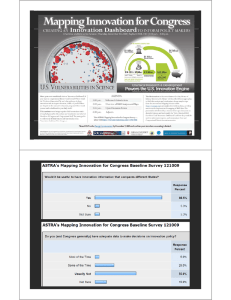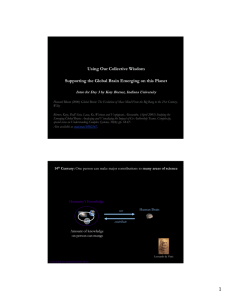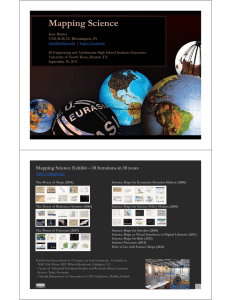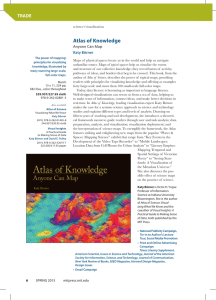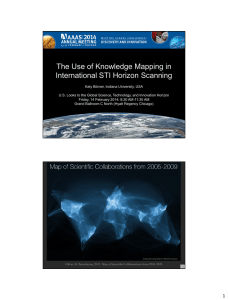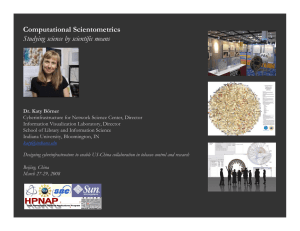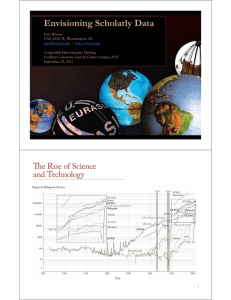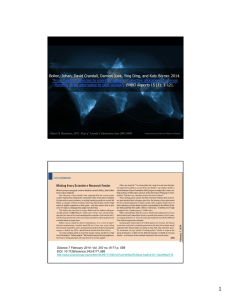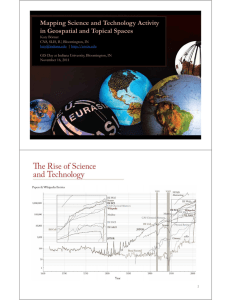Managing Humanity's Knowledge & Expertise
advertisement
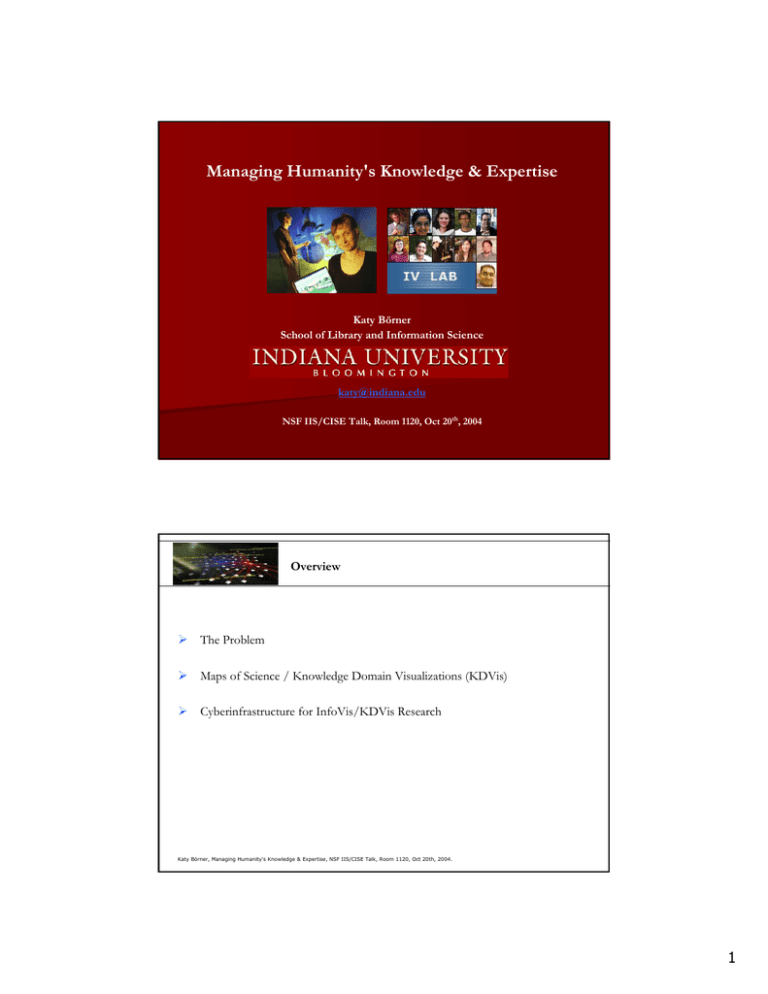
Managing Humanity's Knowledge & Expertise Katy Börner School of Library and Information Science katy@indiana.edu NSF IIS/CISE Talk, Room 1120, Oct 20th, 2004 Overview ¾ The Problem ¾ Maps of Science / Knowledge Domain Visualizations (KDVis) ¾ Cyberinfrastructure for InfoVis/KDVis Research Katy Börner, Managing Humanity's Knowledge & Expertise, NSF IIS/CISE Talk, Room 1120, Oct 20th, 2004. 1 1. The Problem Facing the Information Flood: ¾ Information available in electronic form doubles every 18 months. ¾ Human perception stays constant. ¾ Main means to access knowledge are search engines. ¾ Almost no development in online search interfaces. Can’t pack more text. Let’s see how little our means of accessing information have changed using http://www.archive.org/. Katy Börner, Managing Humanity's Knowledge & Expertise, NSF IIS/CISE Talk, Room 1120, Oct 20th, 2004. 8 years back in time Yahoo Oct 17, 1996 Yahoo Oct 19, 2004 Katy Börner, Managing Humanity's Knowledge & Expertise, NSF IIS/CISE Talk, Room 1120, Oct 20th, 2004. 2 5 years back in time Amazon Sept 02, 1999 Amazon Oct 19, 2004 Katy Börner, Managing Humanity's Knowledge & Expertise, NSF IIS/CISE Talk, Room 1120, Oct 20th, 2004. However, the problem is not how one person can access knowledge but how we can collectively access and manage humanity’s knowledge. Katy Börner, Managing Humanity's Knowledge & Expertise, NSF IIS/CISE Talk, Room 1120, Oct 20th, 2004. 3 14th Century: One person can make major contributions to many areas of science Humanity’s Knowledge use Human Brain contribute Amount of knowledge on person can mange Leonardo da Vinci Circle of Life was designed by Elaine Maier 20th Century: One person can make major contributions to a few areas of science Humanity’s Knowledge use Human Brain contribute Albert Einstein Circle of Life was designed by Elaine Maier 4 21th Century: One person can make major contributions to a specific area of science Humanity’s Knowledge use Human Brain contribute Circle of Life was designed by Elaine Maier 21th Century: How to collectively contribute to all areas of science? Humanity’s Knowledge Human Brains use contribute Circle of Life was designed by Elaine Maier 5 Manager Domain Expert Humanity’s Knowledge Given the steadily increasing flood of information, how can we keep track and make use of what we collectively know? ¾ Shift user’s mental load from slow reading to faster perceptual processes such as visual pattern recognition. ¾ Give people global knowledge of the structure and evolution of scientific knowledge. Æ Global maps of science ¾ Provide access to knowledge and expertise. Æ … & expertise ¾ Aim for reusability of data and methods/approaches/algorithms and reproducibility of results. Æ Interrelate data, code, results, authors. ¾ Use usage log data to support social navigation and to create novel reputation systems. Æ … & usage data. = A new infrastructure to keep track of knowledge. Katy Börner, Managing Humanity's Knowledge & Expertise, NSF IIS/CISE Talk, Room 1120, Oct 20th, 2004. 6 2. Global Maps of Science / Knowledge Domain Visualizations Katy Börner, Managing Humanity's Knowledge & Expertise, NSF IIS/CISE Talk, Room 1120, Oct 20th, 2004. 2. Global Maps of Science / Knowledge Domain Visualizations Help answer questions such as: ¾ What are the major research areas, experts, institutions, regions, nations, grants, publications, journals in xx research? ¾ Which areas are most insular? ¾ What are the main connections for each area? ¾ What is the relative speed of areas? ¾ Which areas are the most dynamic/static? ¾ What new research areas are evolving? ¾ Impact of xx research on other fields? ¾ How does funding influence the number and quality of publications? Answers are needed by funding agencies, companies, and researchers. Katy Börner, Managing Humanity's Knowledge & Expertise, NSF IIS/CISE Talk, Room 1120, Oct 20th, 2004. 7 User Groups ¾ Students can gain an overview of a particular knowledge domain, identify major research areas, experts, institutions, grants, publications, patents, citations, and journals as well as their interconnections, or see the influence of certain theories. ¾ Researchers can monitor and access research results, relevant funding opportunities, potential collaborators inside and outside the fields of inquiry, the dynamics (speed of growth, diversification) of scientific fields, and complementary capabilities. ¾ Grant agencies/R&D managers could use the maps to select reviewers or expert panels, to augment peer-review, to monitor (long-term) money flow and research developments, evaluate funding strategies for different programs, decisions on project durations, and funding patterns, but also to identify the impact of strategic and applied research funding programs. ¾ Industry can use the maps to access scientific results and knowledge carriers, to detect research frontiers, etc. Information on needed technologies could be incorporated into the maps, facilitating industry pulls for specific directions of research. ¾ Data providers benefit as the maps provide unique visual interfaces to digital libraries. ¾ Last but not least, the availability of dynamically evolving maps of science (as ubiquitous as daily weather forecast maps) would dramatically improve the communication of scientific results to the general public. Katy Börner, Managing Humanity's Knowledge & Expertise, NSF IIS/CISE Talk, Room 1120, Oct 20th, 2004. Process of Analyzing and Mapping Knowledge Domains , Topics Börner, Katy, Chen, Chaomei, and Boyack, Kevin. (2003) Visualizing Knowledge Domains. In Blaise Cronin (Ed.), Annual Review of Information Science & Technology, Volume 37, Medford, NJ: Information Today, Inc./American Society for Information Science and Technology, chapter 5, pp. 179-255. Katy Börner, Managing Humanity's Knowledge & Expertise, NSF IIS/CISE Talk, Room 1120, Oct 20th, 2004. 8 Historiograph of DNA Development (Garfield, Sher, & Torpie, 1964) Direct or strongly implied citation Indirect citation Katy Börner, Managing Humanity's Knowledge & Expertise, NSF IIS/CISE Talk, Room 1120, Oct 20th, 2004. Visualizing a discipline: An author co-citation analysis of information science, 1972-1995. (White & McCain, 1998) 9 Visualizing science by citation mapping (Small, 1999) Legend Circle size ~ # papers published Börner, Managing Humanity's Knowledge & Expertise, NSF IIS/CISE Talk, Room 1120, Oct 20th, 2004. CircleKatydistance ~ # co-citations between fields Katy Börner, Managing Humanity's Knowledge & Expertise, NSF IIS/CISE Talk, Room 1120, Oct 20th, 2004. 10 Co-author Networks (Newman, 2001a, 2001b) Katy Börner, Managing Humanity's Knowledge & Expertise, NSF IIS/CISE Talk, Room 1120, Oct 20th, 2004. Visualizing a knowledge domain's intellectual structure. (Chen & Paul, 2001) Katy Börner, Managing Humanity's Knowledge & Expertise, NSF IIS/CISE Talk, Room 1120, Oct 20th, 2004. 11 Cartographic Information Visualization (Skupin, 2002) Katy Börner, Managing Humanity's Knowledge & Expertise, NSF IIS/CISE Talk, Room 1120, Oct 20th, 2004. (Skupin, 2002) Katy Börner, Managing Humanity's Knowledge & Expertise, NSF IIS/CISE Talk, Room 1120, Oct 20th, 2004. 12 Indicator-Assisted Evaluation and Funding of Research Visualizing the influence of grants on the number and citation counts of research papers (Boyack & Börner, 2003) Katy Börner, Managing Humanity's Knowledge & Expertise, NSF IIS/CISE Talk, Room 1120, Oct 20th, 2004. Mapping Topic Bursts (Mane & Börner, 2004) Co-word space of the top 50 highly frequent and bursty words used in the top 10% most highly cited PNAS publications in 1982-2001. Katy Börner, Managing Humanity's Knowledge & Expertise, NSF IIS/CISE Talk, Room 1120, Oct 20th, 2004. 13 Mapping Medline Papers, Genes, and Proteins Related to Melanoma Research (Boyack, Mane & Börner, 2004) Katy Börner, Managing Humanity's Knowledge & Expertise, NSF IIS/CISE Talk, Room 1120, Oct 20th, 2004. Co-PI Map of Current IDM Awardees (Ke & Börner, 2004) Legend Node size: # awarded grants Node Inner Color: # unique Co-PIs (0 white; 1 YellowGreen; 2 Green; 3 PineGreen; 4 Orange; 5 Red; 6 Maroon) Node Border Color: Grant Source (Career "Yellow"; Pecase "Blue"; ITR "Green"; SGER "Pink"; other "White"; MultiGrants "Red") Edge Width: # times people Co-PI’d Edge Color: First year of CoPIship (1999 Maroon; 2000 Red; 2001 Orange; 2002 PineGreen; 2003 Green; 2004 YellowGreen) Career awardees are not showing except they have other IDM grant support as well. Katy Börner, Managing Humanity's Knowledge & Expertise, NSF IIS/CISE Talk, Room 1120, Oct 20th, 2004. 14 Mapping InfoVis Co-Authorships (Interactive Map) IV Contest Submission (Ke, Visvanath & Börner, 2004) Mapping the Evolution of Co-Authorship Networks Won 1st price at the IEEE InfoVis Contest (Ke, Visvanath & Börner, 2004) Katy Börner, Managing Humanity's Knowledge & Expertise, NSF IIS/CISE Talk, Room 1120, Oct 20th, 2004. 15 1988 Katy Börner, Managing Humanity's Knowledge & Expertise, NSF IIS/CISE Talk, Room 1120, Oct 20th, 2004. 1989 Katy Börner, Managing Humanity's Knowledge & Expertise, NSF IIS/CISE Talk, Room 1120, Oct 20th, 2004. 16 1990 Katy Börner, Managing Humanity's Knowledge & Expertise, NSF IIS/CISE Talk, Room 1120, Oct 20th, 2004. 1991 Katy Börner, Managing Humanity's Knowledge & Expertise, NSF IIS/CISE Talk, Room 1120, Oct 20th, 2004. 17 1992 Katy Börner, Managing Humanity's Knowledge & Expertise, NSF IIS/CISE Talk, Room 1120, Oct 20th, 2004. 1993 Katy Börner, Managing Humanity's Knowledge & Expertise, NSF IIS/CISE Talk, Room 1120, Oct 20th, 2004. 18 1994 Katy Börner, Managing Humanity's Knowledge & Expertise, NSF IIS/CISE Talk, Room 1120, Oct 20th, 2004. 1995 Katy Börner, Managing Humanity's Knowledge & Expertise, NSF IIS/CISE Talk, Room 1120, Oct 20th, 2004. 19 1996 Katy Börner, Managing Humanity's Knowledge & Expertise, NSF IIS/CISE Talk, Room 1120, Oct 20th, 2004. 1997 Katy Börner, Managing Humanity's Knowledge & Expertise, NSF IIS/CISE Talk, Room 1120, Oct 20th, 2004. 20 1998 Katy Börner, Managing Humanity's Knowledge & Expertise, NSF IIS/CISE Talk, Room 1120, Oct 20th, 2004. 1999 Katy Börner, Managing Humanity's Knowledge & Expertise, NSF IIS/CISE Talk, Room 1120, Oct 20th, 2004. 21 2000 Katy Börner, Managing Humanity's Knowledge & Expertise, NSF IIS/CISE Talk, Room 1120, Oct 20th, 2004. 2001 Katy Börner, Managing Humanity's Knowledge & Expertise, NSF IIS/CISE Talk, Room 1120, Oct 20th, 2004. 22 2002 Katy Börner, Managing Humanity's Knowledge & Expertise, NSF IIS/CISE Talk, Room 1120, Oct 20th, 2004. 2003 Katy Börner, Managing Humanity's Knowledge & Expertise, NSF IIS/CISE Talk, Room 1120, Oct 20th, 2004. 23 2004 Katy Börner, Managing Humanity's Knowledge & Expertise, NSF IIS/CISE Talk, Room 1120, Oct 20th, 2004. 24 ¾ Diverse attempts have been made to generate maps of science. ¾ Most have concentrated on specific knowledge domains due to data availability and scalability of algorithms. ¾ Cartographic metaphors seem to work well as they exploit the map reading skills people acquire in their education. ¾ Ideally, maps of science would resemble weather forecast maps in that they not only show the structure but also the dynamics of scientific evolution and progress. It is just today, that we have the data, code and compute power to study science using the scientific methods of science as suggested by Derek J. deSolla Price about 40 years ago. However, generating a map of science requires a computational effort common in physics or biology but not in the social sciences. However, maps of science will benefit every field. Katy Börner, Managing Humanity's Knowledge & Expertise, NSF IIS/CISE Talk, Room 1120, Oct 20th, 2004. 3. Cyberinfrastructure for InfoVis / KDVis Research Katy Börner, Managing Humanity's Knowledge & Expertise, NSF IIS/CISE Talk, Room 1120, Oct 20th, 2004. 25 3. Cyberinfrastructure for InfoVis / KDVis Research Katy Börner, Managing Humanity's Knowledge & Expertise, NSF IIS/CISE Talk, Room 1120, Oct 20th, 2004. IVC Database (http://iv.slis.indiana.edu/db) Katy Börner, Managing Humanity's Knowledge & Expertise, NSF IIS/CISE Talk, Room 1120, Oct 20th, 2004. 26 Katy Börner, Managing Humanity's Knowledge & Expertise, NSF IIS/CISE Talk, Room 1120, Oct 20th, 2004. Katy Börner, Managing Humanity's Knowledge & Expertise, NSF IIS/CISE Talk, Room 1120, Oct 20th, 2004. 27 Katy Börner, Managing Humanity's Knowledge & Expertise, NSF IIS/CISE Talk, Room 1120, Oct 20th, 2004. IVC Software Framework (http://iv.slis.indiana.edu/iv) Katy Börner, Managing Humanity's Knowledge & Expertise, NSF IIS/CISE Talk, Room 1120, Oct 20th, 2004. 28 http://vw.indiana.edu/ivsi2004/ Katy Börner, Managing Humanity's Knowledge & Expertise, NSF IIS/CISE Talk, Room 1120, Oct 20th, 2004. 29 IVC Learning Modules (http://iv.slis.indiana.edu/lm) Katy Börner, Managing Humanity's Knowledge & Expertise, NSF IIS/CISE Talk, Room 1120, Oct 20th, 2004. Visualizing Tree Data http://iv.slis.indi ana.edu/lm/lmtrees.html Katy Börner, Managing Humanity's Knowledge & Expertise, NSF IIS/CISE Talk, Room 1120, Oct 20th, 2004. 30 Student’s Project Results User & Task Analysis for Visualizing Tree Data ¾ Visualizing the structure of IU’s Decision Support System ¾ Visualizing the co-occurences of keywords in DLib Magazine articles. ¾ Visualization of the Java API ¾ Visualizing the the Library of Congress Classification System to retrieve legal materials in a library. See Handin pages at http://ella.slis.indiana.edu/~katy/ handin/L579-S04/cgi/handinlogin.cgi Image by Peter Hook and Rongke Gao Katy Börner, Managing Humanity's Knowledge & Expertise, NSF IIS/CISE Talk, Room 1120, Oct 20th, 2004. Time Series Analysis & Visualization http://iv.slis.indiana .edu/lm/lm-timeseries.html Katy Börner, Managing Humanity's Knowledge & Expertise, NSF IIS/CISE Talk, Room 1120, Oct 20th, 2004. 31 Visualizing the Work of the United States Supreme Court Based on Time Data and Top Level West Topics by Peter A. Hook & Rongke Gao Top fifteen most occurring topics from 1944 to 2004 in Timesearcher All topics grouped by West Category and All topics by West Category and Sub-Category grouped Sub-Category grouped over the entire lengths of Katy Börner, Managing Humanity's Knowledge & Expertise, NSF IIS/CISE Talk, Room 1120, Oct 20th, 2004. corresponding to the five chief justices the data set Visualizing Niches of the Blog Universe By Mike Tyworth and Elijah Wright Visualizing niches of the blog universe. Katy Börner, Managing Humanity's Knowledge & Expertise, NSF IIS/CISE Talk, Room 1120, Oct 20th, 2004. 32 Given the steadily increasing flood of information, how can we keep track and make use of what we collectively know? ¾ Shift user’s mental load from slow reading to faster perceptual processes such as visual pattern recognition. ¾ Give people global knowledge of the structure and evolution of scientific knowledge. Æ Global maps of science ¾ Provide access to knowledge and expertise. Æ … & expertise ¾ Aim for reusability of data and methods/approaches/algorithms and reproducibility of results. Æ Interrelate data, code, results, authors. ¾ Use usage log data to support social navigation and to create novel reputation systems. Æ … & usage data. Basically, a new infrastructure to keep track of knowledge. Katy Börner, Managing Humanity's Knowledge & Expertise, NSF IIS/CISE Talk, Room 1120, Oct 20th, 2004. Data-Code-Computing Cyberinfrastructures that Interrelate Data, Code, Papers, Authors & Usage Data Authors Papers Usage data Code Data Katy Börner, Managing Humanity's Knowledge & Expertise, NSF IIS/CISE Talk, Room 1120, Oct 20th, 2004. 33 Data-code-computing cyberinfrastructures that interrelate data, code, results, authors, and usage data ¾ Enable data/algorithm/result comparison at data/code/data level. ¾ Facilitate new types of searches, e.g., retrieve all users that worked with data set x, retrieve all papers that used algorithm y. ¾ Support algorithm comparison and re-use, e.g., the re-application of an algorithm sequence reported in a paper to a different data set. ¾ Do provide bridges between algorithm developers and users. ¾ Could provide a great testbed application for novel ways to store, preserve, integrate, correlate, access, analyze, map or interact with data. ¾ Are of interest to diverse communities. Katy Börner, Managing Humanity's Knowledge & Expertise, NSF IIS/CISE Talk, Room 1120, Oct 20th, 2004. http://vw.indiana.edu/aag05 34 Acknowledgements & References Support comes from the School of Library and Information Science, Indiana University's High Performance Network Applications Program, a Pervasive Technology Lab Fellowship, an Academic Equipment Grant by SUN Microsystems, NIA, and an SBC (formerly Ameritech) Fellow Grant. This material is based upon work supported by the National Science Foundation under Grant No. DUE-0333623 and IIS-0238261. ¾ Ord, Terry J., Martins, Emília P., Thakur, Sidharth, Mane, Ketan K., and Börner, Katy. (in press) Trends in animal behaviour research (1968-2002): Ethoinformatics and mining library databases. Animal Behaviour. ¾ Chen, Chaomei and Börner, Katy. (in press). The Spatial-Semantic Impact of a Collaborative Information Virtual Environment on Group Dynamics. PRESENCE, 14(1). ¾ Mane, Ketan K. and Börner, Katy. (2004). Mapping Topics and Topic Bursts in PNAS. Proceedings of the National Academy of Sciences of the United States of America, 101(Suppl. 1):5287-5290. ¾ Börner, Katy, Maru, Jeegar and Goldstone, Robert. (2004). The Simultaneous Evolution of Author and Paper Networks. Proceedings of the National Academy of Sciences of the United States of America, 101(Suppl_1):5266-5273. ¾ Börner, Katy and Penumarthy, Shashikant. (2003). Social Diffusion Patterns in Three-Dimensional Virtual Worlds. Information Visualization, 2(3):182-198. ¾ Boyack, Kevin W. and Börner, Katy. (2003). Indicator-Assisted Evaluation and Funding of Research: Visualizing the Influence of Grants on the Number and Citation Counts of Research Papers, Journal of the American Society of Information Science and Technology, Special Topic Issue on Visualizing Scientific Paradigms, 54(5):447-461. ¾ Börner, Katy, Chen, Chaomei, and Boyack, Kevin. (2003). Visualizing Knowledge Domains. In Blaise Cronin (Ed.), Annual Review of Information Science & Technology, Volume 37, Medford, NJ: Information Today, Inc./American Society for Information Science and Technology, chapter 5, pp. 179-255. ¾ Börner, Katy and Chen, Chaomei (Eds.) (2002). Visual Interfaces to Digital Libraries. Springer Verlag, LNCS 2539. Katy Börner, Managing Humanity's Knowledge & Expertise, NSF IIS/CISE Talk, Room 1120, Oct 20th, 2004. 35
